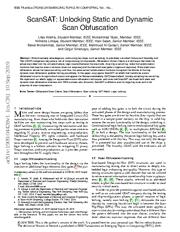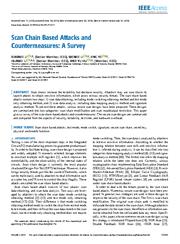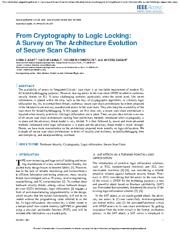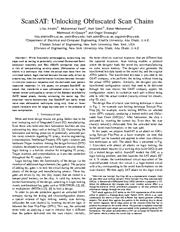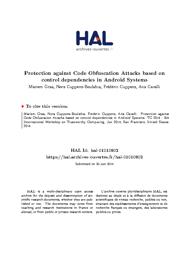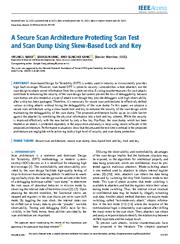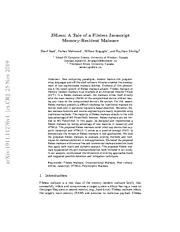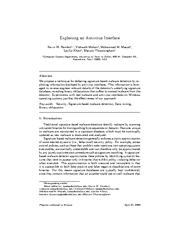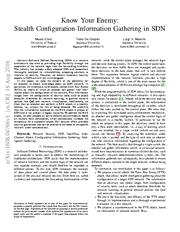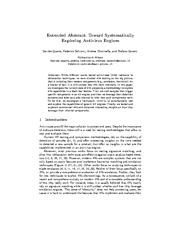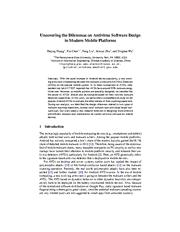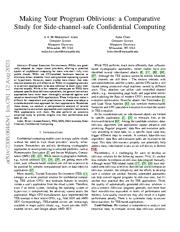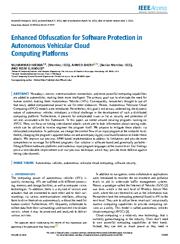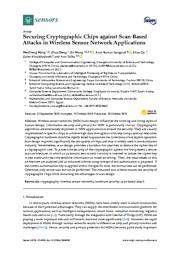A copy of this work was available on the public web and has been preserved in the Wayback Machine. The capture dates from 2022; you can also visit the original URL.
The file type is application/pdf.
Filters
A Memristor-based Secure Scan Design against the Scan-based Side-Channel Attacks
2022
Proceedings of the Great Lakes Symposium on VLSI 2022
Scan chain design can improve the testability of a circuit while it can be used as a side-channel to access the sensitive information inside a cryptographic chip for the crack of cipher key. ...
Otherwise, the data in some scan cells are obfuscated by the random bits, which are generated by reading the status of a memristor. ...
and in part by Project JCYJ20190806143203510 and GXWD20201230155427003-20200824112646001 from Shenzhen Fundamental Science Research Foundation. ...
doi:10.1145/3526241.3530345
fatcat:myay3nwwynfddhui3x2hz73izy
ScanSAT: Unlocking Static and Dynamic Scan Obfuscation
[article]
2019
arXiv
pre-print
We implement our attack, apply on representative scan obfuscation techniques, and show that ScanSAT can break both static and dynamic scan obfuscation schemes with 100% success rate. ...
While static scan obfuscation utilizes the same secret key, and thus, the same secret transformation functions throughout the lifetime of the chip, dynamic scan obfuscation updates the key periodically ...
CONCLUSION Obfuscation of scan chains aims to protect against the untrusted testers; static and dynamic scan locking techniques obfuscate the scan operations, hiding the relationship between the scan-in ...
arXiv:1909.04428v1
fatcat:4j7fifgr65dj7lhdcrrcy5b6x4
Scan Chain Based Attacks and Countermeasures: A Survey
2019
IEEE Access
This paper gives a survey of the scan chain-based attacks and countermeasures. ...
The scan chain-based attacks contain two steps: 1) scan data obtaining, including mode switching obtaining method and test mode only obtaining method, and 2) scan data analysis, including data mapping ...
STATIC AND DYNAMIC OBFUSCATION OF SCAN DATA In [40] and [41] , secure design based on static and dynamic obfuscation of scan data is proposed. ...
doi:10.1109/access.2019.2925237
fatcat:muhsso67xvgw3f3nxt73fysce4
From Cryptography to Logic Locking: A Survey on The Architecture Evolution of Secure Scan Chains
2021
IEEE Access
We evaluate all secure scan chain architectures in terms of security and resiliency, testability/debugging time and complexity, and area/power/delay overhead. ...
It is then followed by newer and more advanced methods introduced when logic obfuscation is in place and the adversary threat model is much stronger. ...
obfuscated circuits, such as scan-based side-channel attacks, the SAT attack, and leaking-based attacks, show that having a secure scan chain architecture is indispensable while the sensitive data is ...
doi:10.1109/access.2021.3080257
fatcat:tg7fcofqenb6dakqiwlt3q3kd4
ScanSAT: Unlocking Obfuscated Scan Chains
[article]
2019
IACR Cryptology ePrint Archive
In this paper, we propose ScanSAT: an attack that transforms a scan obfuscated circuit to its logiclocked version and applies a variant of the Boolean satisfiability (SAT) based attack, thereby extracting ...
Our empirical results demonstrate that ScanSAT can easily break naive scan obfuscation techniques using only three or fewer attack iterations even for large key sizes and in the presence of scan compression ...
MRC provides no protection against ScanSAT, as ScanSAT operates only in the test mode. Static vs. dynamic obfuscation. ...
dblp:journals/iacr/AlrahisYSMAS19
fatcat:7xinwbbuvvaxfbc6aq5n46dfsq
Protection against Code Obfuscation Attacks Based on Control Dependencies in Android Systems
2014
2014 IEEE Eighth International Conference on Software Security and Reliability-Companion
We propose a technical solution based on a hybrid approach that combines static and dynamic analysis. We formally specify our solution based on two propagation rules. ...
Thus, it can be circumvented by an obfuscated code attack based on control dependencies. In this paper, we present a collection of obfuscated code attacks on TaintDroid system. ...
A side channel attack is another category of attacks that can be used to obfuscate code and to leak private information. ...
doi:10.1109/sere-c.2014.33
dblp:conf/ssiri/GraaCCC14
fatcat:csly7zrnargubinxkwr4nlkfpe
A Secure Scan Architecture Protecting Scan Test and Scan Dump Using Skew-Based Lock and Key
2021
IEEE Access
In this paper, we propose a secure scan architecture using a skew-based lock and key to enhance the security of the scan design while maintaining the debuggability of the scan dump. ...
INDEX TERMS Secure scan architecture, secure scan dump, skew-based lock and key, lock and key. ...
While the scan data are defended against scan-based side-channel attacks, debugging requires preserving the snapshot at the scan dump mode. ...
doi:10.1109/access.2021.3097348
fatcat:nhducotmbbfy3dtzoqikqehwga
JSLess: A Tale of a Fileless Javascript Memory-Resident Malware
[article]
2019
arXiv
pre-print
We tested the proposed fileless malware with several free and commercial malware detection tools that apply both static and dynamic analysis. ...
For this reason, fileless malware presents a difficult challenge for traditional malware detection tools and in particular signature-based detection. ...
We hope our research will help to raise awareness of the emerging unconventional malware threats. ...
arXiv:1911.11276v1
fatcat:ipikl2onnzdcrhnftroklcod4q
Exploiting an antivirus interface
2009
Computer Standards & Interfaces
Experiments with real malware and antivirus interfaces on Windows operating systems justifies the effectiveness of our approach. ...
This information is leveraged to reverse engineer relevant details of the detector's underlying signature database, revealing binary obfuscations that suffice to conceal malware from the detector. ...
Signature-based malware detection generally enforces a static approximation of some desired dynamic (i.e., behavioral) security policy. ...
doi:10.1016/j.csi.2009.04.004
fatcat:eyt7am33kbf27myws3mbfv7zwm
Know Your Enemy: Stealth Configuration-Information Gathering in SDN
[article]
2016
arXiv
pre-print
To address the KYE attack, we also propose an active defense countermeasure based on network flows obfuscation, which considerably increases the complexity for a successful attack. ...
This information ranges from the configuration of security tools, such as attack detection thresholds for network scanning, to general network policies like QoS and network virtualization. ...
Fig. 8 . 8 Overview of the flow obfuscation countermeasure. The red dashed lines indicate the flow table side-channel. ...
arXiv:1608.04766v1
fatcat:fqjk7j3w6bcrviwvhh7qsqktcy
Extended Abstract: Toward Systematically Exploring Antivirus Engines
[chapter]
2018
Lecture Notes in Computer Science
First, we craft samples that trigger specific components in an AV engine, and then we leverage their detection outcome and label as a side channel to infer how such components work. ...
To do this, we developed a framework, crAVe, to automatically test and explore the capabilities of generic AV engines. ...
Moreover, most previous works focus on testing signature matching, and show how obfuscation techniques are effective against static analysis-based detectors [12, 6, 26, 27, 29] . ...
doi:10.1007/978-3-319-93411-2_18
fatcat:6okdibt7pjgtnbp2qjimzfyxgi
Uncovering the Dilemmas on Antivirus Software Design in Modern Mobile Platforms
[chapter]
2015
Lecture Notes of the Institute for Computer Sciences, Social Informatics and Telecommunications Engineering
During our analysis, we identified the design dilemmas related to two types of malware scanning operations, namely local malware scan and cloud-based malware scan. ...
However, as mobile systems are specially designed, we consider that the power of AVDs' should also be evaluated based on their runtime malware detection capabilities. ...
Our new evasion techniques exploit the cloud-based malware scanning behavior of the AVDs, and they are complementary to obfuscation-based or other evasion techniques. ...
doi:10.1007/978-3-319-23802-9_27
fatcat:o5htbkbwffh73hrcsa5ehk6qfq
Making Your Program Oblivious: a Comparative Study for Side-channel-safe Confidential Computing
[article]
2023
arXiv
pre-print
However, recent studies have shown that side-channel attacks are still effective on TEEs. An appealing solution is to convert applications to be data oblivious to deter many side-channel attacks. ...
While a few research prototypes on TEEs have adopted specific data oblivious operations, the general conversion approaches have never been thoroughly compared against and tested on benchmark TEE applications ...
Side Channel Attacks on TEEs Since the advent of TEEs, many studies have explored the weaknesses of TEE side channels. ...
arXiv:2308.06442v1
fatcat:zp5lbwxrsjagpiozqb2irtenui
Enhanced Obfuscation for Software Protection in Autonomous Vehicular Cloud Computing Platforms
2022
IEEE Access
Our findings prove a considerable improvement over our previous technique, which may provide more defense against timing side-channels. ...
We propose to mitigate these attacks via obfuscated compilation. ...
One of the most serious security threats are side channel attacks (SCA). In our work, we proposed an obfuscation mechanism to protect software running on AVCC against timing SCA. ...
doi:10.1109/access.2022.3159249
fatcat:jncnl2ki7jdyhpa5lgxwyx7lli
Securing Cryptographic Chips against Scan-Based Attacks in Wireless Sensor Network Applications
2019
Sensors
Nevertheless, scan design provides a backdoor for attackers to deduce the cipher key of a cryptographic core. ...
Scan design improves significantly the test quality of chips and thus is widely used in semiconductor industry. ...
Conflicts of Interest: The authors declare no conflict of interest. ...
doi:10.3390/s19204598
fatcat:yo5bvzdzznebhoaklquogkwe3i
« Previous
Showing results 1 — 15 out of 1,412 results


